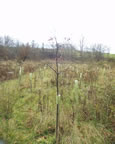The Forest Community
By: Brandon Martin
(Click any thumbnail picture to enlarge)
Riparian forests are wooded buffer zones along streams, cree
ks, lakes, and rivers. They are classified by the plant species, soils and hydrology of the area.
These special forested communities protect waterways from intensive land use practices such as timber harvesting, cattle grazing, or agricultural production. Riparian forests filter nutrients such as nitrogen and phosphorus; as
well as sediment from erosion
processes and minimize the amounts of these pollutants reaching the watercourse. Tree roots stabilize stream banks and slow water velocities in times of high water allowing sediments to be deposited.
Riparian forests are some of the most diverse wildlife habitats on earth. They provide a wide array of wildlife needs including: food, water, cover, and space. Many riparian forests connect adjacent blocks of timber and naturally become
wildlife travel corridors. Many aquatic fish
species prefer to live in forested environments where insects and cover are readily available.
Many acres of riparian forests have been lost to development and intensive land use practices in the past. It is the goal of forest managers, to protect and re-establish riparian forest buffers where they once stood. One way in which riparian forest buffers are being established is though the planting of riparian species. Bare-root seedlings in a variety of buffer species can be purchased from your local forestry office or extension service. Many conservation easements also exist which can
help with the cost of seedlings and planting. To see how to plant a bare-root seedling please click here!
To learn more about riparian forests visit the Virginia Department of Forestry’s website on riparian forest buffers at www.dof.virginia.gov/rfb/rfb-intro.shtml.
Questions:
- Where are riparian forests?
- Do riparian forest minimize pollutants in water?
- Do riparian forests provide diverse wildlife habitats?
